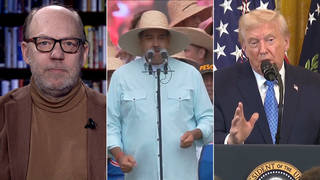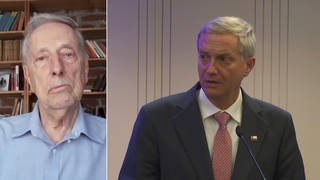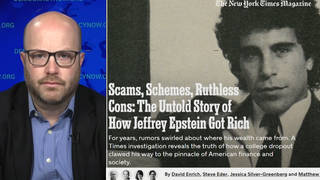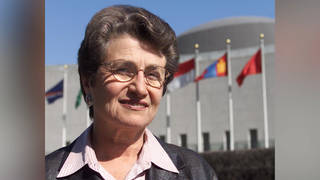
Topics
Guests
- Lisa Fithianlongtime organizer, member of Extinction Rebellion’s national team and author of Shut It Down: Stories from a Fierce, Loving Resistance.
Activist and organizer Lisa Fithian looks back on decades of activism and paves a road forward for current movements in her new book, “Shut It Down: Stories from a Fierce, Loving Resistance.” We speak with Fithian in Part 2 of a conversation about protest movements throughout time, combatting the climate crisis, and nonviolent direct action.
Transcript
AMY GOODMAN: This is Democracy Now!, democracynow.org, The War and Peace Report. I’m Amy Goodman, with Part 2 of our discussion with Lisa Fithian. Lisa has shut down the CIA. She’s occupied Wall Street. She’s disrupted the World Trade Organization. She stood her ground in Tahrir Square in Egypt. She’s walked in solidarity with the tribal leaders at Standing Rock and defended communities in the wake of Hurricane Katrina. Yes, described by Mother Jones as “the nation’s best-known protest consultant,” Lisa is living proof the best way to radically and rapidly transform the ills of our society is through nonviolent direct action grounded in strong beliefs, creativity and sheer unwavering courage. In fact, “courage” is on the T-shirt she is wearing today. Lisa Fithian, longtime organizer, has written her life story, which is a history of movements in this country, at least some of them. The book is called Shut It Down: Stories from a Fierce, Loving Resistance. She’s going around the country on a book tour and also with a new workshop, which is called “Escalating Resistance: Mass Rebellion Training.”
Lisa, it’s great to have you here with us to continue our conversation. Talk about how you got your start. How did you become an activist and a real strategist?
LISA FITHIAN: I mean, really, I was kind of juvenile delinquent, because I had a lot of energy, was very curious and got into trouble. And then I learned to — that I needed to channel that differently. And there was a situation one day when I was in high school that, for me, was like just watching disrespect happen. And I got angry about it. And for whatever reason, I decided to become a journalist. And I did an underground newspaper called The Free Thinker, printing it on the mimeograph machine in my mother’s — in my garage with my mom. And changes happened because of that. We distributed it. Conversations started happening. I was like, “Wow!” And then there was a situation where I was like — learned about injustice. And so, those two lessons, that, you know, injustice happens and people working together can change that, because we organized around that, and we changed things again in high school — so, I learned very early on that we could make a difference in this world.
AMY GOODMAN: You quote your dad at the beginning of the book.
LISA FITHIAN: Yeah, yeah.
AMY GOODMAN: You said, “He told me, 'Once upon a time, poetry and science were one, and they called it magic.'”
LISA FITHIAN: Yeah. I think that’s what we do in the streets, Amy. I mean, this work is about magic. It’s the alchemy. It’s taking all of these things together and, like, creating something new. And it’s dynamic, and it’s ever moving. And when we’re really doing it well, it’s joyful and beautiful. And we do — we change lives through this work. You know, that’s why I do it. I just watch people come to life.
AMY GOODMAN: Talk about your early work with Abbie Hoffman, and explain for the younger set who he is.
LISA FITHIAN: Yeah, yeah, yeah. Abbie Hoffman was a radical in the ’60s. He was one of the founders of the Youth International Party, the Yippies. He was a creative, tried to elevate — levitate the Pentagon. He threw money on Wall Street and had the the stockbrokers scrambling on the floor. And he was part of the the protest outside the Democratic Convention in 1968, where he was arrested and put on trial with eight other people as part of the Chicago 8. But Abbie, he was a brilliant strategist. He really taught me about strategy. He was visionary. But he also taught me the power of the creative tactics and the sort of culture jamming. And so, I definitely feel like I walk in his shoes and, you know, continue to his legacy.
AMY GOODMAN: So, let’s go back to 1987. We referred to it in Part 1 of the interview. But ’87, you shut down the CIA. Give us the context, the time. What happened in Washington?
LISA FITHIAN: Right. I shut it down with lots of other people. It was the era of the Reagan administration’s war in Central America. It was an era where people of faith and people of conscience rose up across this country and formed a group called the Pledge of Resistance, who were willing to put their bodies on the line to stop injustice. We knew that the CIA was behind the counterinsurgency wars, the creation of the Contras, which was the U.S.-funded resistance to the people of Nicaragua and the new Sandinista government. So, we did many things. We took over federal buildings. There were fasts. Brian Willson lost his leg blocking trains in California.
AMY GOODMAN: That were carrying armaments.
LISA FITHIAN: They were carrying weapons from the Concord weapons plant.
AMY GOODMAN: And the train run over him.
LISA FITHIAN: Yes, the train ran over him. I think it’s an anniversary this year. But we knew the CIA was — we had to face the CIA. And sometimes in this work you have to face the things that are most scary. And so, over a thousand people organized. We trained them, hundreds of people on the east lot of the Capitol in Washington, D.C. We formed affinity groups, which are these small self-organized groups that will take care of each other in the action. We had a plan to blockade every entrance into the CIA headquarters from all directions.
AMY GOODMAN: We’re showing a map, from your book, of the main gate of the CIA headquarters and this 1987 protest assembly site.
LISA FITHIAN: Right. And so, we just came from all directions. People were incredibly creative. We had a lot of whistleblowers from the CIA that were out there telling the truth.
AMY GOODMAN: Like Dan Ellsberg.
LISA FITHIAN: Dan Ellsberg, John Stockwell. Yep, Daniel Ellsberg was — he was such an important influence back then. And people, you know, shut it down. And some people had to trace — go through the woods to get to the north gate. And they were beaten, quite frankly. It was not — you know, nonviolent civil disobedience is really taking risks, and it’s a courageous act. And, you know, we can definitely [inaudible] —
AMY GOODMAN: Hundreds of people were arrested.
LISA FITHIAN: Hundreds. Over close to 600 people were arrested. And we, you know, paralyzed traffic in all of northern Virginia. And, you know, it was on the front page of every major newspaper in the country, again, just demonstrating people putting their bodies, shutting it down and creating social disruption.
AMY GOODMAN: Let’s jump forward to 1999, because —
LISA FITHIAN: Yeah.
AMY GOODMAN: — we’re coming up on the anniversary, the 20th anniversary of the shutting down of the World Trade Organization in Seattle. This November marks that 20th anniversary, the historic protests in Seattle. Let’s go to that moment when protesters in Seattle learned they had successfully stopped the WTO ministerial from starting through nonviolent direct action. This is a clip from the documentary This Is What Democracy Looks Like. It features the protesters in a scene with trade delegates trying to attend the opening session.
PROTESTER: We are successfully blocking out delegates. This is a success!
SECURITY: We are making available for you to leave now. There are protesters at the end of 6th Avenue and [inaudible] end of our block. So you’d be left out right in the middle of the protests. I recommend you stay here, if you can.
UNIDENTIFIED: Yes, yes.
TRADE DELEGATE: The opening session is still postponed. I have not — I called and asked for an immediate update. They said to relax, put your feet up, go to your hotel room, relax, have lunch or — until the situation is safer out there.
SECURITY: I would stay here.
TRADE DELEGATE: You cannot get to the — you cannot get to the Paramount. You cannot get to the Paramount right now.
AMY GOODMAN: And this is the trade unionists.
STEELWORKER: We had a rally down at the docks. And we went through the Pike market and came up to the corner and saw those police chasing the kids down the street. These are the same kids that have been marching with us. They weren’t doing anything wrong.
RON JUDD: People got pissed. And I had trade unionists who, just a matter of days before, were saying we shouldn’t be out there, calling me up, saying, “When are we going to protest next? I want to be there, because what’s going on is wrong.”
AMY GOODMAN: So, that’s from the documentary This Is What Democracy Looks Like, Jacquie Soohen, Rick Rowley, produced by Indymedia and Big Noise Films. Indymedia was the birth of Indymedia.
LISA FITHIAN: Absolutely, and it changed the world, too, you know, getting people’s stories out all over the world.
AMY GOODMAN: As CNN was reporting what the government was saying in Seattle — “We are not shooting rubber bullets” — you had Indymedia.org showing people holding handfuls of rubber bullets. And there were more hits to Indymedia.org than there were to CNN then, because people were understanding who to believe.
LISA FITHIAN: Absolutely, absolutely, yeah. And I love those clips, too, because I think one of the things it really shows is the importance of solidarity between people in different movements. You know, the government tries to divide us all the time and talk about tactics that divide, but we have to stay together. We can do different things, but — it just happened in Hong Kong, too. The older folks are supporting the youth. That makes all the difference in whether we’re going to change the world or not, being together and backing each other up.
AMY GOODMAN: So, explain what happened there. The World Trade Organization — this is during the time of Clinton.
LISA FITHIAN: Yes.
AMY GOODMAN: Right? You had the Secretary of State Madeleine Albright not able to get out of her room, and tear gas is seeping under her hotel room door.
LISA FITHIAN: Yeah, yeah.
AMY GOODMAN: And President Clinton coming in in the middle of the night.
LISA FITHIAN: Right.
AMY GOODMAN: But why were the protests? It’s not just about strategy. You’re deeply inspired by the politics of what’s going on.
LISA FITHIAN: Right, right.
AMY GOODMAN: What is it that you objected to?
LISA FITHIAN: Well, the — I’ll just call them the capitalists, were in the process of — you know, this institution, the World Trade Organization, was going to be the judge and jury of trade agreements. Three people. Totally undemocratic. And we know that it was always going to basically rule in favor of the Global North. And so people all around the world came together to say no. Yes, there was fighting for democracy, human rights, labor rights, control of resources. But we were also saying no to these undemocratic processes and saying these are illegitimate.
AMY GOODMAN: Lisa, let’s go to you in 1999 in Seattle. It’s a short clip.
LISA FITHIAN: Part of the legal team people just came up to us over here and said that the curfew has actually been moved to 5, not 7:30.
AMY GOODMAN: That’s from Big Noise Films. And you’re immediately organizing, talking about the legal teams. How was that organized?
LISA FITHIAN: It was an amazing operation in Seattle, and the organization. And one of the things that we did there is the legal teams helped people understand the power of noncooperation and a willingness to refuse to give our names, refuse to walk away and to basically, you know, use every way we could to resist what the state was doing. There was a martial law put in place, the curfew. And so, that’s — you know, I was arrested the day after, because we violated the curfew and the martial law and we just went down anyway.
AMY GOODMAN: Hundreds and hundreds.
LISA FITHIAN: Hundreds of us.
AMY GOODMAN: Over 600 people were arrested.
LISA FITHIAN: Over 600 people. And the —
AMY GOODMAN: Ultimately, the police chief was forced out, and he said it was his worst mistake of his life. He seemed to agree with his ouster. He said they saw — the police saw the protesters, the Teamsters and the Turtles together, the high school students, the nurses, the doctors, the French farmers. He said, “When we have these kind of military weapons” —
LISA FITHIAN: Yeah.
AMY GOODMAN: This is the police chief, right? — “we see our neighbors as the enemy.”
LISA FITHIAN: Absolutely. And that was another marker of the WTO protests, is this clear militarization of the police and the willingness of the state to enact violence on people who are basically exercising their First Amendment rights, with butterfly wings and trees and marching bands and tubas. You know, we were faced with tear gas, pepper spray, full-on weapons. It was a — as I say a lot, Amy, in this work, we have to face the horror and the awe.
AMY GOODMAN: And interestingly, Norm Stamper, then the police chief, who was ousted, then goes around the country talking against the militarization of police.
LISA FITHIAN: Right.
AMY GOODMAN: But I want to go to Katrina in 2005.
LISA FITHIAN: OK.
AMY GOODMAN: Talk about Hurricane Katrina making landfall, the devastation, and then how you and so many others organized, what you set up.
LISA FITHIAN: You know, Hurricane Katrina was a moment where that militarization of the police continued. You know, we basically — the global justice movement, our legal workers, our medical workers — we all knew that we had to go, because we were watching as the government was not helping people but turning their guns on the people, particularly black and brown people, and imprisoning them for “looting.” There was all these little lies that were being told about what was happening on the ground. And so, people of conscience and political people, we knew we had to go. And Malik Rahim, a longtime Black Panther and organizer in his community in Algiers, put out a call. And we came. And we basically, sort of top to bottom, built a parallel society to make sure that people could get water, could get food, could get their homes clean, could get trees off their roofs, to get legal help.
AMY GOODMAN: So, I want to go to 2006.
LISA FITHIAN: Yeah.
AMY GOODMAN: We spoke to New Orleans community activist Malik Rahim and asked him to describe the Common Ground Collective, the community organization he co-founded in the aftermath of Hurricane Katrina the year before.
MALIK RAHIM: We have about 15 different operations. To name a few, we have our Ninth Ward distribution center, our Lower Ninth Ward distribution center, our distribution center that we operate with Four Directions up in Dulac, which is in Houma, where we assist the Native American community there. We have our legal clinic. We have our — again, now we operate three health clinics. We operate two: our uptown — I mean, our West Bank health clinic and our East Bank health clinic. Then we have one that we assist the immigrant population, who is totally being enslaved in Louisiana, because we have avaricious businessmen that’s going around Central America enticing people to come to America, promising them all type of wages.
AMY GOODMAN: That was former Black Panther Malik Rahim —
LISA FITHIAN: Yeah.
AMY GOODMAN: — helps to found the Common Ground Collective, really runs it. You get involved with that. Has organizing changed, and especially around the climate crisis? I mean, that was 2005, Hurricane Katrina. Now we’re dealing with Dorian and so many others, so often the frontline communities most hurt, most vulnerable.
LISA FITHIAN: Mm-hmm, who get the least help. We’ve seen that again and again. I mean, when Hurricane Sandy hit New York, you saw a grassroots response through Occupy Sandy. There was a grassroots response in Puerto Rico around Maria. So, there’s actually a group now called Mutual Aid Disaster Relief, that came out of folks that were part of Common Ground, that are continuing to organize.
But one of the things that’s different is, yes, we have to continue to prepare ourselves for these disasters, because they’re going to continue to come. And that’s something we can start doing now. But we also have to make sure that we are really planning to work in solidarity with the communities that are hit, because we know that they’re going to — some of the black and brown communities will be left to dry. But we have to actually, you know, try and stop the conditions that are causing these disasters, before it’s too late. And some say it is too late. But, you know, people have different windows of how much time do we have. We’ve heard 2050. Now we hear maybe 12 years. And that’s why, you know, I have been working more and so inspired by what’s happening around people rising up around climate right now.
AMY GOODMAN: And Extinction Rebellion. Where we started this interview, let’s end.
LISA FITHIAN: Exactly. So, Extinction Rebellion is, you know, one of the most important movements right now, I believe, because they are not trying to, like, just get — water down our message so that everybody can buy in. We’re not just trying to get legislation passed. We’re trying to create the kind of social disruptions that’s forcing the people in power to do what they have to do, because all the solutions exist. We have all the resources we need. I mean, Jimmy Carter had solar panels on the White House in the '70s through the oil crisis. So we've known for a long time that this problem is coming. But the political will to do the right thing? We also know, and it’s part of the work around the climate, is that after World War II, there was a massive plan to restructure the economy. We need a massive plan to restructure the economy right now.
AMY GOODMAN: How has organizing changed, the big lessons? And that’s where we’ll end.
LISA FITHIAN: Well, certainly, social media has changed organizing, from on the ground to sort of in the air. And it’s — you know, it is important, but I always say to the young people, you have to have those relationships. You have to be able to, like, know how to communicate without that, because if the government pulls the plug, you’re in trouble. And we’re seeing again and again how disconnecting the internet is a form of state repression right now that’s happening to many movements. So, we have got to —
AMY GOODMAN: Not to mention if the climate does.
LISA FITHIAN: And, right, the climate, as well, exactly. Systems go down. And so, what does it look like to be in relationship to meet each other’s needs? And I think that’s the other thing I’d say about what I’ve learned over these years. This work is traumatizing. We have to do the work to heal as we do it. To take the risks we have to take and face, we have to organize in what I call a holistic way. We have to make sure that all of our needs are being met — emotional, physical, spiritual. And so, I’m working more and more to integrate these healing practices, these community-building practices, understanding the importance of solidarity, understanding our ability to stand together when we face this onslaught coming at us, and to not only resist, but to act with courage and love, because that’s what we’ve got.
AMY GOODMAN: Well, I want to thank you so much, Lisa. Lisa Fithian has just written her memoir, which is really a history of organizing in this country over the last decades. She’s a longtime organizer. Her book is Shut It Down: Stories from a Fierce, Loving Resistance, as she travels the country with her new workshop, “Escalating Resistance: Mass Rebellion Training..”
To see Part 1 of our discussion, go to democracynow.org. I’m Amy Goodman. Thanks so much for joining us.











Media Options